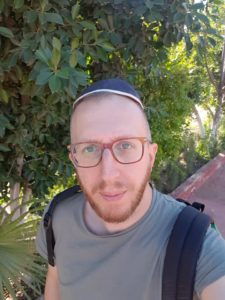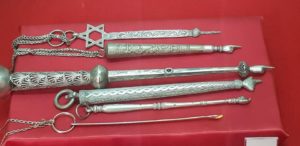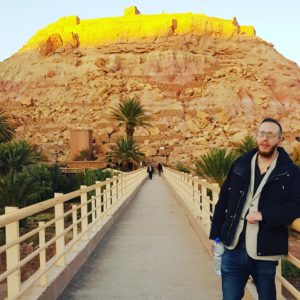A personal reflection on Jewish Morocco
I have the Jewish Museum in London to thank.
Ten years ago, the museum hosted a stunning exhibition on the Jews of southern Morocco. The photos on display captured a mystical world which awoke my interest in this ancient part of the Maghreb.

It also afforded me an opportunity to learn about the old ‘mellahs’ of the Atlas mountains – not ‘ghettos’ in the 20th century sense of the word – but nevertheless enclaves, where Jews were permitted to live and work.
The exhibition contrasted the work of Pauline Prior, a Dutch ethnologist who in 2008 travelled to sites of former mellahs, and Elias Harrus, a prominent leader of the Alliance Israélite Universelle. He was at the heart of these communities back in the 1950s.
Harrus took photographs of vibrant commercial and religious life. Some of the most striking of these featured Jewish onion sellers at the Sunday market in Demnate and Jewish women milling grain. The most exceptional photo at the exhibition was of a woman, Malka, the leader of the Asaflou community. On planning Aliyah, she asked Harrus, “who will watch over our dead?”
A hunger to learn more
In the first part of the Jewish Museum exhibition, I started to imagine what had become of these hamlets and towns, some of which (in the 1950s at least) boasted six or seven synagogues. I had an image of them – sixty years hence – populated by a few shepherds and their tribe of goats.

I turned a corner. Pauline Prior sought to evoke Elias Harrus’ world, but in many cases all she could find were remnants of these Atlas mountain communities. Be it cemeteries or old shrines, she nevertheless highlighted how these sacred sites are still guarded with love and attention by the region’s Berbers. Above all, I left the exhibition embarrassed I lacked knowledge of all Jewish existence in the region. I was determined to learn more.
The mellahs of southern Morocco
The 1936 Census revealed that 161,942 Jews lived in Morocco. In truth, hundreds of thousands, perhaps millions more lived here, dating back two thousand years.
The history books suggest many of the country’s Jews so naturally co-existed alongside their Berber neighbours, the two communities were difficult to tell apart.

Harvey E. Goldberg in his work on the Mellahs of Southern Morocco reminds us of the historical thesis of the Judaized Berbers. The argument is that many of the tribes of North Africa had accepted a form of Judaism in the pre-Islamic period. And that “consequently, many of today’s North African Jews are the descendants of Berbers”
Or were Berbers in effect ‘Judaized’, wearing the same dress, speaking the same dialects, learning in some cases Arabic from their Jewish brethren? No doubt there are many scholars for whom the debate remains unresolved.
In the first half of the twentieth century, colonialists, anthropologists and artists all made inroads trying to better understand Jewish life in what Arnan Zafrir in his 1961 documentary termed, ‘The Edge of the West’.

And in the case of figures like Pauline Prior, there is something about the exceptionalism and foreignness of Jews in Morocco that has compelled writers and adventurers to seek out and survey Jewish life ever since, both in shul and on the streets.
More recent still, boutique travel and personalized holiday options have proliferated to take the 21st century traveller direct to where the action is. One such option is Alecia Cohen’s Marrakech Jewish Heritage Tour.
Chronicling Morocco’s Jewish past
In the mid-twentieth century Zeyde Schulmann, born in Palestine, tried to photograph Jews “as they were”, not as case studies, but as individuals. He wanted to photograph people – particularly women – attempting to transcend their traditional roles.
There were others like Didier Madras, who immortalized the stereotypical image of the Jewish merchant, sat cross-legged selling their wares, with Arabs hooded in djellaba standing in the souk behind them.

Some of the major sources of Jewish life in the mellahs of Morocco worked especially hard to comprehend this alien tribe. De Foucaluld, a chronicler of these colourful communities, even resorted to dressing as a European rabbi to try and make sense of it all and immerse himself.
Others such as photographer Jean Besancenot went a conventional, but no less fascinating route, taking studied portraits of Jewish girls laden heavy with silver decorative brooches.

A trip to the exceptional Maison de la Photographie de Marrakech helps you to get close and personal to these postcards and books illustrated with heliogravures. In Harrus’ photos at the Jewish Museum’s memorable exhibition, out stared the faces of young, proud, handsome men keen on their new social status as educated, informed Zionists.
I have seen similar faces: at another (temporary exhibition) at El Badi Palace in Marrakech, a most un-Jewish site. In close proximity to the Marrakech mellah, El Badi is a wonder with its vast arcades.
However, for me, the most fascinating detail was the 1950 photo of young Jews in wide-collared shirts and cardigans at ‘Georges et Maurice Leven’ school, incongruously on display beneath the palace.
The Gateway of the Sahara
Far from the modern metropolis of Casablanca, where most of the country’s remaining 2,500 or so Jews live today, the ‘Gateway to the Sahara’ in the south provides a profound, even spiritual experience. Although the oases aren’t far from the frenzied souks of Marrakech, they are distant enough to feel a peacefulness that is only ever fleeting in the ‘Red City’.
The area represents the ultimate experience in imagining the old caravan routes that traders used to take to Timbuktu. They would set off for the fifty-two day journey to Mali by camel or donkey, but nowadays, you have the famed Tizi n’ Tichka pass through the mountains that you can travel by coach.
Only the brave cross in a Grand Taxi, given the drivers’ inclination to overtake every vehicle that stands in their way. I opted instead for the more comfortable Supratours. A short plane journey is another possibility, but with snowy peaks, tiny Berber settlements; crags the colours of Neapolitan flavoured-ice cream: driving through the Atlas corridor is a sight to behold in its own right.
Ouarzazate is the best strategic base to locate yourself. The French developed it as a provincial centre in the region as part of their early 20th century protectorate.
For hundreds of miles around, you are spoilt with the quality of views David Lean sought out to film Lawrence of Arabia, and which more recently, Ridley Scott has come back, time-and-again, to use for his film locations, notably the Russell Crowe epic, Gladiator.
Riad Ksar Aylan had dinner ready for me on arrival. There is luminescent olive oil and plentiful honey to coat warmed bread with, before a lamb tagine gets served. The team can also organize day trips, which my friends and I took full advantage of. Kasbah Tifoultoute reminded us of the abandoned City of Oz. A wizened man was on hand to prepare us sweet mint tea as we looked at the reaches of the verdant valleys below.
On to Telouet
The next day, Omar, our driver (a Berber) was the perfect guide to take us further afield, to Telouet. The rocks to our side resembled the grainy Harsha bread generously laid on at our Riad for breakfast; white dots sprinkled over the pale pink-brown colour of women’s blusher. There were minarets in every village we drove through, not altogether different from the church steeples you might see in Alpine towns. 
Omar grew emotional at one point. He got out of the car and asked us to concentrate on the canyons below. “Jews are Moroccans” he told me. It almost came out of nowhere, although I suspect the Riad had informed him I was Jewish.
He remembered how he and his community cried when the Jews, his neighbours, left in 1963. He remembered how they made finely crafted shoes – ‘babouches’ – the popular slippers many tourists take home as Moroccan gifts today.
He added how the Jews were “capable” and smiled widely, reflecting on their skill at using wool. He took us to a Zaouia [much like the shrines for Islamic reverence] a five-minute drive from Telouet. It marked the tomb of a man who I could only assume was a rabbinical elder. Pilgrims come to pay their respects, far-away from their new homes in Canada, France and Israel.

In the main, they come for the Hillula, a public anniversary of Jewish saints known in Hebrew as a Saddiq. The festival of Lag B’Omer sees large numbers returning.
Local shepherds walking with their donkey and hay spoke to Omar and told him they remember the elders that Jewish people return to sanctify. There were apparently two hundred tombs in this cemetery alone.
Two Berber offered us to come home for tea. We smelt the herbs along their path and spotted distant mud-mounds that resembled a giant tortoise, its small head rising out of the land, with its enormous shell behind.
A poem to Jewish Morocco
Later we went to postcard-perfect Aït Benhaddou which is the most superb Kasbah in the whole of southern Morocco. Determined to capture the best possible photos, shadows dancing behind us in the dimming light, Omar pointed to a walled off cemetery to the north.
“Jewish,” he added, with a hint of pride. He was also keen to point out the many examples of Judaica, menorahs and even old window shutters with Magen David designs, which were being sold on the way back to our car.
My non-Jewish friends asked me if, before travelling to Morocco, I had known all of this would be here to discover.
“Not quite,” I replied.

I knew there would be history to touch and see, but southern Morocco offers a peculiar potion, not just of enchanting sights, but tastes, sounds and smells too.
Most important for me personally, the trip was a poignant poem to Morocco’s Jewish past. Sadly, there might not be so many people in future to recite it; who can remember the history first-hand. For now, there are Berbers, like Omar, in his seventies. Mistaking me for a Russian, he told me to go home and spread the news of this place and how for generations, Jews called it their land.

